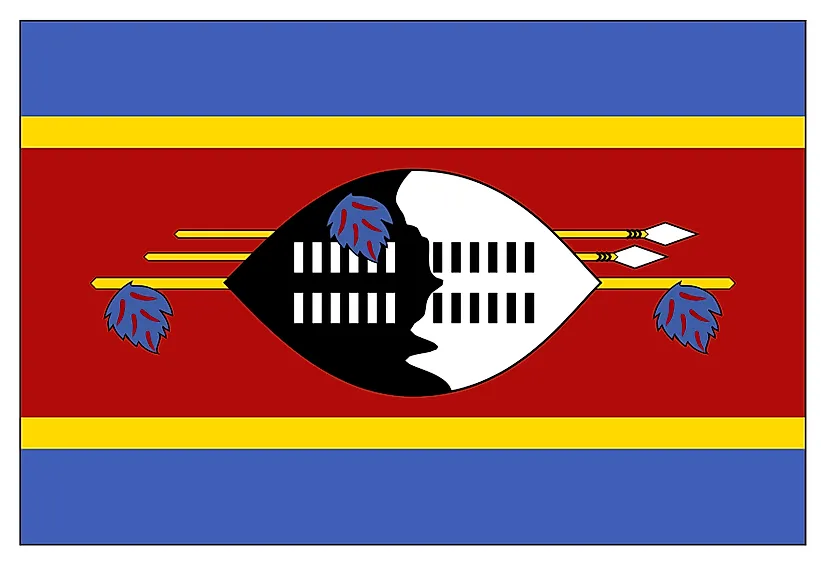
에스와티니
| 대륙 | 아프리카 |
| 자본 | 음바바네 |
| 인구 | 1,451,428 |
| GDP | $10.94억 |
| 1인당 GDP | $9,800 |
| 다이얼링 코드 | +268 |
| ISO 코드(2글자) | SZ |
| ISO 코드(3글자) | SWZ |
에스와티니 소개
아프리카 남부의 고대 전통과 현대적 발전이 만나는 나라, 에스와티니(구 스와질란드)에 오신 것을 환영합니다. 17,364㎢의 면적에 약 120만 명의 인구가 거주하는 에스와티니는 풍부한 문화유산과 다양한 풍경이 어우러져 전통 군주제와 현대 사회가 독특하게 조화를 이루고 있습니다.
지리적 특징과 자연의 아름다움
에스와티니의 지형은 1,862미터에 이르는 산부터 저지대 사바나까지 다양한 지형으로 이루어져 있어 작은 크기에도 불구하고 놀라울 정도로 다양성을 자랑합니다. 에스와티니는 크게 네 개의 지역으로 나뉩니다: 하이벨트, 미들벨트, 로우벨트, 루봄보 고원지대입니다.
하이벨트 지역에는 드라마틱한 산과 숲이 있고 로벨트 지역에는 전형적인 아프리카 사파리 풍경이 펼쳐져 있습니다. 믈릴와네 야생동물 보호구역과 흘레인 왕립 국립공원에서는 코뿔소, 코끼리, 수많은 조류 등 다양한 야생동물을 만나볼 수 있습니다.
이 나라의 다양한 고도는 짧은 거리 내에 여러 기후대를 형성하여 다양한 생태계와 농업 활동을 지원합니다. 만텐가 폭포를 비롯한 강과 폭포는 자연의 아름다움을 더합니다.
문화 유산과 전통
에스와티니 문화는 군주제와 스와지 전통 관습을 중심으로 형성되어 있으며, 특히 움랑가(갈대 춤)와 인콸라 같은 의식에서 그 특징이 잘 드러납니다. 매년 열리는 이 행사에는 수천 명의 참가자와 관중이 모여 문화유산과 화합을 축하합니다.
전통 예술에는 독특한 구슬 세공, 풀 직조, 나무 조각 등이 있습니다. 스와지 음악과 춤은 다양한 의식과 행사와 관련된 특정 공연과 함께 문화 생활에 필수적인 요소로 남아 있습니다.
이 나라는 현대 제도와 함께 강력한 전통적 통치 구조를 유지하고 있으며, 군주제가 문화와 정치 생활에서 중심적인 역할을 하고 있습니다. 특히 의식에서 입는 전통 복장은 이 나라의 풍부한 문화 유산을 반영합니다.
역사 여행
에스와티니의 역사는 초기 정착부터 식민지 시대의 영향을 거쳐 1968년 독립에 이르기까지 다양합니다. 이 나라는 영국의 보호 아래 식민지 시대 내내 군주제와 전통 문화의 대부분을 독특하게 유지했습니다.
최근 수십 년 동안 스와질랜드는 전통적인 거버넌스와 현대적인 개발 과제 사이에서 균형을 유지해 왔습니다. 2018년 스와질란드에서 에스와티니로 국명을 변경한 것은 전통적인 정체성으로의 회귀를 반영한 것입니다.
현대 경제 환경
오늘날 에스와티니는 농업, 임업, 광업, 제조업에 기반을 둔 다양한 경제를 가지고 있습니다. 설탕 생산과 섬유 산업으로 잘 알려져 있으며 관광업도 중요한 산업으로 계속 성장하고 있습니다.
최근의 개발 이니셔티브는 인프라 개선과 경제 다각화에 중점을 두고 있습니다. 이 나라는 지역 경제 공동체에 가입하여 무역과 개발을 지원하고 있습니다.
국제 관계 및 글로벌 포지셔닝
에스와티니는 지역기구에 적극적으로 참여하고 있으며 다양한 국제 파트너십을 발전시켜 왔습니다. 절대 군주국으로서의 독특한 지위와 문화 유산으로 인해 국제적인 주목을 받고 있습니다.
알고 계셨나요?
- 에스와티니는 아프리카의 마지막 절대 군주국인가요?
- 움랑가(갈대 춤) 행사에는 매년 수천 명의 참가자가 모인다고요?
- 세계에서 HIV 유병률이 가장 높은 나라 중 하나이지만 치료에는 상당한 진전이 있었나요?
- 에스와티니는 재활용 유리로 독특한 수제 유리 제품을 생산하나요?
결론
에스와티니는 현대 아프리카에서 전통 통치 방식과 문화가 놀랍게 보존된 대표적인 국가입니다. 산악 고원부터 저지대 사바나까지, 전통 의식부터 발전하는 산업에 이르기까지 에스와티니는 독특한 문화적 정체성을 유지하면서 계속 발전하고 있습니다. 에스와티니는 경제 개발과 공중 보건을 비롯한 현대적 과제를 해결하면서 지속 가능한 발전을 추구하는 동시에 고유한 유산을 보존하기 위해 노력하고 있습니다.





